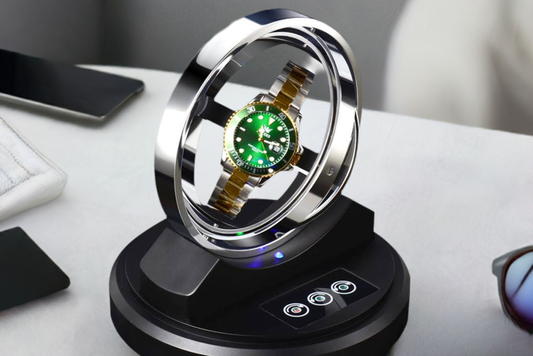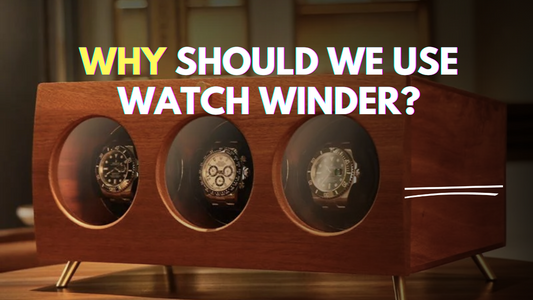Automatic watches, also known as self-winding watches, are a fascinating blend of mechanical ingenuity and human motion. These timepieces have captivated watch enthusiasts for decades with their ability to keep precise time without the need for manual winding. In this article, we will explore the inner workings of automatic watches and discover how these self-winding marvels function.
The Rotor: The Heart of an Automatic Watch
At the core of every automatic watch lies the rotor, a half-moon shaped weight that oscillates with the wearer's movements. This ingenious component is responsible for converting kinetic energy into mechanical energy, which in turn winds the mainspring and powers the watch's gears and hands.
How the Rotor Functions
The rotor's primary function is to harness the wearer's movements and translate them into energy. As the wearer moves their arm, the rotor oscillates, rotating around its axis. This rotation is connected to a ratchet mechanism that winds the mainspring. The mainspring stores the energy generated by the rotor's movements, which is then released as the watch's gears and hands move.
Bidirectional Winding Technology
Modern automatic watches are equipped with bidirectional winding technology, allowing them to wind in both clockwise and counterclockwise directions. This ensures that the watch captures energy from every movement, no matter the direction. A clever system of gears and clutches enables the rotor to wind the mainspring in both directions.
For example, the Rolex Perpetual Rotor, found in many of Rolex's automatic watches, is a bidirectional winding system that captures energy from the wearer's movements in both directions. This efficient system allows the watch to wind quickly and accurately, ensuring a consistent power reserve.
Similarly, the Omega Seamaster Planet Ocean features a bidirectional winding mechanism integrated into the rotor, which is decorated with a wave-patterned finish. This not only adds aesthetic appeal but also enhances the watch's ability to capture energy from the wearer's movements.
Other notable examples of bidirectional winding watches include the Breitling Navitimer, the IWC Portugieser, and the Jaeger-LeCoultre Master Control. These watches showcase the innovative technology that has gone into developing efficient and accurate automatic winding mechanisms.
The Mainspring: Energy Storage and Power Reserve
The mainspring is the heart of an automatic watch, responsible for storing the energy that powers the watch's mechanical movement. This long, thin, spiral-shaped spring is made of a specialized alloy designed to store energy through the winding process. As the mainspring is wound, either manually or automatically through the wearer's movements, it coils tighter, storing potential energy.
As the mainspring gradually releases its stored energy, it transmits it to the gear train, a system of interlocking gears that transmit power to the watch's hands. This consistent release of energy ensures accurate and reliable timekeeping. The mainspring's energy storage capacity is typically measured in joules, with higher-quality watches often featuring mainsprings capable of storing more energy.
For instance, the Rolex Submariner, a popular automatic dive watch, features a mainspring that can store up to 70 hours of power reserve. This means that if the watch is fully wound and then left still, it will continue to accurately keep time for up to 70 hours before needing to be rewound.
Factors Influencing Power Reserve
The power reserve of an automatic watch is influenced by several factors, including the size and material of the mainspring, the efficiency of the gear train, and the friction within the movement. Watches with larger mainsprings or more efficient gear trains tend to have longer power reserves. Additionally, modern materials and technologies, such as silicon components, have improved the efficiency of mechanical movements, allowing for longer power reserves.
Different watches achieve varying power reserves due to these factors. For example:
- The Patek Philippe Calatrava, a high-end automatic dress watch, boasts a power reserve of up to 45 hours.
- The Omega Seamaster Planet Ocean, a high-performance automatic dive watch, features a power reserve of up to 60 hours.
- The Tissot Le Locle, a mid-range automatic watch, offers a power reserve of up to 80 hours.
The Gear Train: A Cascade of Motion
The intricate system of gears in an automatic watch, known as the gear train, is responsible for transferring energy from the mainspring to the balance wheel. This complex system is composed of several interconnected gears that work together to transmit power and control the watch's accuracy.
-
Mainspring: The primary power source of the watch, wound up by the wearer's movements and converted into mechanical energy through the rotor.
-
Gear Train: A complex system of gears that transmits energy from the mainspring to the balance wheel. The gears are arranged in a specific order to ensure efficient and accurate energy transmission.
-
Gear Ratios: The gears in the gear train have specific ratios that determine the speed and torque of the energy transmission. These ratios are carefully designed to ensure that the balance wheel receives the precise amount of energy required to maintain the watch's accuracy.
-
Escape Wheel: The final gear in the gear train, responsible for releasing the energy to the balance wheel at a controlled rate, allowing the watch to accurately keep time.
-
Balance Wheel: The heart of the watch's timekeeping mechanism, oscillating back and forth to divide time into equal parts. The balance wheel is connected to the escape wheel and receives the energy released by it, which in turn regulates the watch's timekeeping.
Regulating Time: How the Gear Train's Precision Controls Accuracy
The gear train's precision plays a crucial role in regulating the watch's accuracy. Here are some key aspects of how the gear train controls the watch's accuracy:
-
Gear Ratios: The precise gear ratios in the gear train ensure that the energy is transmitted at the correct speed and torque, ensuring that the balance wheel receives the exact amount of energy required to maintain accuracy.
-
Escape Wheel: The escape wheel releases the energy to the balance wheel at a controlled rate, allowing the watch to accurately keep time. The escape wheel's precise movement ensures that the balance wheel oscillates at a consistent frequency.
-
Balance Wheel: The balance wheel's oscillations are controlled by the energy released by the escape wheel. The balance wheel's precise oscillations ensure that the watch's timekeeping is accurate and consistent.
-
Adjustments: Watchmakers can adjust the gear train and balance wheel to fine-tune the watch's accuracy. This involves making precise adjustments to the gear ratios, escape wheel, and balance wheel to ensure that the watch keeps accurate time.
-
Quality Control: The quality of the gear train and its components is critical to the watch's accuracy. High-quality watches have gear trains that are carefully crafted and assembled to ensure precision and accuracy.
The Balance Wheel: Oscillation and Precision
The balance wheel is the core component responsible for maintaining accurate time in mechanical watches. It operates by oscillating, or swinging back and forth, typically between 18,000 to 36,000 times per hour (vph), depending on the watch caliber. This oscillation is crucial for dividing time into equal parts, ensuring the watch's precision. The balance wheel's oscillations are comparable to a miniaturized pendulum, stabilized by the escapement mechanism.
To illustrate the precision, let's look at the Omega Seamaster Aqua Terra, which features the Omega Calibre 8800 movement. This movement boasts a frequency of 25,200 vph, resulting in an impressive accuracy of -0/+5 seconds per day. Similarly, the Rolex Submariner, equipped with the Rolex Calibre 3235 movement, oscillates at 28,800 vph, ensuring a precision of -2/+2 seconds per day.
Temperature and Shock Resistance
Advances in materials have significantly enhanced the protection of the balance wheel against temperature fluctuations and shock. Modern watches often employ specialized alloys and treatments to minimize the impact of these external factors. For instance, the Rolex Parachrom hairspring, used in several Rolex models, is made from a paramagnetic alloy that resists magnetic interference and remains stable in extreme temperatures (-20°C to +40°C).
The Omega Master Chronometer certification, which includes the Seamaster Planet Ocean, involves rigorous testing for resistance to magnetic fields up to 15,000 gauss. This is achieved through the use of anti-magnetic materials like silicon and Omega's proprietary Nivagauss alloy. Additionally, the Patek Philippe Advanced Research department has developed the Spiromax balance spring, which combines a silinvar (silicon-aluminum) core with a patented terminal curve, enhancing its resistance to temperature variations and shocks.
In terms of shock resistance, many modern watches incorporate advanced materials and designs to protect the balance wheel. The Seiko Prospex 9S85 movement, for example, features a Diashock shock-absorbing system that helps maintain the balance wheel's stability during impacts. Similarly, the IWC Portugieser Perpetual Calendar employs a shock-absorbing mechanism to safeguard the balance wheel against sudden movements.
These advancements in materials and design have significantly improved the reliability and accuracy of automatic watches, making them more durable and precise timekeeping instruments.
Craftsmanship and Heritage
Automatic watches are a testament to the artistry and history of watchmaking. The intricate mechanisms and precise engineering involved in creating these timepieces have been refined over centuries. The traditional assembly of automatic watches involves a high level of craftsmanship, with skilled watchmakers carefully assembling and adjusting the numerous components that make up the movement.
One of the most iconic examples of automatic watch craftsmanship is the Patek Philippe Calibre 89, considered one of the most complicated watches ever made. This masterpiece features 33 complications, including a perpetual calendar, moon phase, and minute repeater, and took nine years to develop.
In modern times, innovations such as the use of advanced materials like ceramic and titanium have further elevated the craftsmanship of automatic watches. For instance, the Omega Seamaster Planet Ocean 600M features a ceramic bezel and a titanium case, making it both durable and stylish.
Personal Connection
Automatic watches create a unique emotional bond between the wearer and the watch. The fact that the watch is powered by the wearer's movements makes it a personal and intimate accessory. This connection is deeply rooted in the history of watchmaking, where timepieces were often passed down through generations as family heirlooms.
The emotional connection is also reinforced by the ritual of winding the watch, which becomes a daily habit that strengthens the bond between the wearer and the watch. This ritual is often accompanied by a sense of pride and ownership, as the wearer feels a sense of accomplishment in keeping their timepiece running.
Furthermore, automatic watches often feature intricate engravings, decorations, and other aesthetic elements that make each piece unique. For example, the Audemars Piguet Royal Oak features an iconic octagonal bezel and a beautifully decorated movement, making it a true work of art.
In terms of statistics, it's worth noting that the global market for automatic watches is projected to reach $12.4 billion by 2025, with a compound annual growth rate of 4.5% from 2020 to 2025. This growth is driven in part by the increasing demand for luxury watches, particularly among younger consumers who value the craftsmanship and heritage behind these timepieces.
Some popular automatic watches include:
- Rolex Submariner (approximately $7,500 - $9,000)
- Omega Seamaster Planet Ocean 600M (approximately $6,000 - $8,000)
- Audemars Piguet Royal Oak (approximately $10,000 - $20,000)
- Patek Philippe Calatrava (approximately $10,000 - $50,000)
Maintenance and Servicing
To ensure the longevity of an automatic watch, it is essential to follow some best practices for maintenance. Here are some tips:
-
Winding: Automatic watches require regular winding to keep them running. The recommended practice is to wind the watch daily, especially if it has been inactive for an extended period. This can be done by wearing the watch regularly or using a watch winder. The frequency of winding depends on the watch's power reserve, which typically ranges from 36 to 40 hours.
-
Setting: When setting the time and date on an automatic watch, avoid doing so between 9 PM and 3 AM. This is because the watch's gears are in a specific position during these hours, and adjusting the time or date may cause damage to the mechanism.
-
Recommended Service Intervals: Automatic watches typically require servicing every 3 to 5 years, depending on usage and environmental factors. Regular servicing ensures that the watch remains accurate and prolongs its lifespan.
Servicing Demystified
Servicing an automatic watch is a crucial process that involves a series of steps to maintain the watch's performance and extend its lifespan. Here's what happens during a service:
-
Disassembly: The watch is disassembled into its various components, including the movement, case, and band.
-
Cleaning: Each component is thoroughly cleaned to remove dirt, grime, and old lubricants.
-
Inspection: The watchmaker inspects each component for signs of wear or damage and replaces any faulty parts.
-
Lubrication: The watch's movement is lubricated with specialized oils to reduce friction and wear.
-
Reassembly: The watch is reassembled, and the movement is adjusted to ensure accurate timekeeping.
-
Testing: The watch is tested for accuracy, water resistance, and other functions to ensure it meets the manufacturer's standards.
Regular servicing is crucial for an automatic watch's performance because it:
- Ensures accurate timekeeping
- Prevents wear and tear on moving parts
- Maintains water resistance
- Prolongs the watch's lifespan
- Preserves the watch's value
Some popular automatic watch brands and their recommended service intervals are:
- Rolex: Every 5 years
- Omega: Every 3 to 5 years
- Tag Heuer: Every 3 to 5 years
- Breitling: Every 3 to 5 years
The cost of servicing an automatic watch varies depending on the brand, model, and location. On average, the cost ranges from $200 to $1,000.
Choosing the Right Automatic Watch
When selecting an automatic watch, there are several key features to consider to ensure that you find the perfect timepiece for your lifestyle and preferences. Here are some essential factors to keep in mind:
-
Complications: Automatic watches often come with various complications, such as date displays, chronographs, GPS, moon phases, and more. Consider the features that are most important to you and look for watches that incorporate those complications.
-
Case Materials: The case material of an automatic watch can significantly impact its durability, weight, and overall aesthetic. Common case materials include stainless steel, titanium, gold, and ceramic. Stainless steel is a popular choice for its durability and affordability, while titanium offers a lightweight and strong option. Gold and ceramic cases provide a more luxurious and stylish appearance.
-
Water Resistance: If you plan to wear your watch while engaging in water-based activities, such as swimming or diving, look for watches with high water resistance ratings. Water resistance is typically measured in meters (e.g., 30m, 100m, 300m), indicating the maximum depth the watch can withstand without damage.
-
Movement Type: Automatic watches can have different movement types, such as in-house movements, third-party movements, or modified movements. In-house movements are designed and manufactured by the watch brand itself, often providing higher quality and precision. Third-party movements are sourced from external suppliers, while modified movements are customized versions of third-party movements.
-
Power Reserve: The power reserve of an automatic watch indicates how long the watch will continue to run without needing to be wound. Power reserves can range from a few hours to several days, depending on the watch's design and efficiency.
-
Accuracy: The accuracy of an automatic watch refers to how closely it keeps time. Look for watches with high accuracy ratings, often measured in seconds per day. High-quality automatic watches typically have accuracy ratings of +- 10-15 seconds per day.
-
Size and Style: Consider the size and style of the watch, as it should fit comfortably on your wrist and suit your personal taste. Watch sizes range from small and elegant to large and sporty, with various styles available, such as dress watches, diver watches, and pilot watches.
Budget vs. Quality
When it comes to automatic watches, the budget vs. quality debate is crucial. Here's a breakdown of what to expect at different price points:
Entry-Level (Under $500)
- Features: Basic automatic movements, simple designs, and limited complications.
- Quality: Decent quality, but may lack precision and durability.
- Examples: Seiko 5 Sports (around $50), Fossil Grant (around $150).
Mid-Range ($500-$2,000)
- Features: Improved automatic movements, additional complications, and better materials.
- Quality: Good quality, with increased precision and durability.
- Examples: Tissot Le Locle (around $500), Omega Seamaster Aqua Terra (around $1,500).
High-End ($2,000-$10,000)
- Features: High-quality in-house movements, advanced complications, and premium materials.
- Quality: Excellent quality, with high precision and durability.




